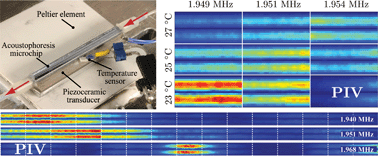Automated and temperature-controlled micro-PIV measurements enabling long-term-stable microchannel acoustophoresis characterization
Abstract
We present a platform for micro

a Department of Measurement Technology and Industrial Electrical Engineering, Lund University, PO-Box 118, Lund, Sweden
b Department of Micro- and Nanotechnology, Technical University of Denmark, DTU Nanotech, Building 345 B, Kongens Lyngby, Denmark
c School of Mechanical Engineering, Purdue University, West Lafayette, IN, USA
d Department of Biomedical Engineering, Dongguk University, Seoul, South Korea
We present a platform for micro

 Please wait while we load your content...
Something went wrong. Try again?
Please wait while we load your content...
Something went wrong. Try again?
P. Augustsson, R. Barnkob, S. T. Wereley, H. Bruus and T. Laurell, Lab Chip, 2011, 11, 4152 DOI: 10.1039/C1LC20637K
To request permission to reproduce material from this article, please go to the Copyright Clearance Center request page.
If you are an author contributing to an RSC publication, you do not need to request permission provided correct acknowledgement is given.
If you are the author of this article, you do not need to request permission to reproduce figures and diagrams provided correct acknowledgement is given. If you want to reproduce the whole article in a third-party publication (excluding your thesis/dissertation for which permission is not required) please go to the Copyright Clearance Center request page.
Read more about how to correctly acknowledge RSC content.
 Fetching data from CrossRef.
Fetching data from CrossRef.
This may take some time to load.
Loading related content
